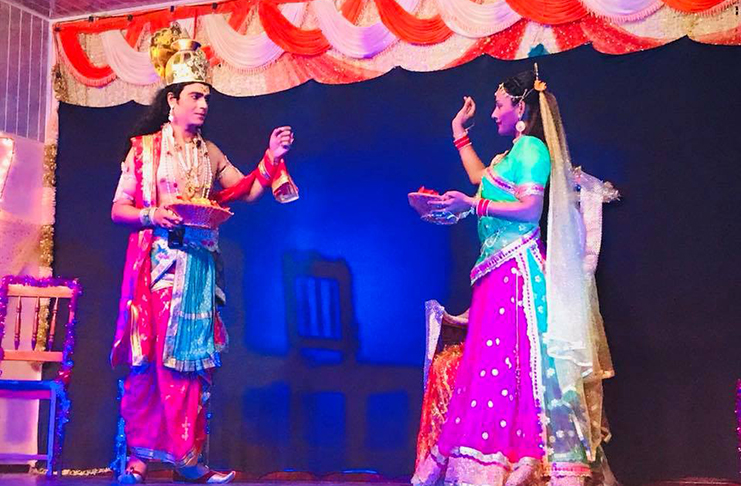IN THE modern era of technology and individuality, the important nature and the communal aspect of ritual and worship are two elements are often not appreciated enough when it comes to our history and our religion, particularly when expressed through cultural forms, such as theatre. These two elements exist in everything from Queh Queh, to Phagwah, to unwrapping presents under the Christmas tree, and yet nature (the natural environment) and the community (the social environment) are often taken for granted when it comes to such celebrations. Enough attention is not being paid to the importance of these two aspects of Guyanese culture and yet, we know that they are important because they have existed since prehistoric times and have managed to retain a presence in contemporary Guyana, having survived slavery, indentureship, and other elements of colonisation that attempted to erase the various cultures of those who came to these shores as enslaved and indentured peoples. Regardless of whether the people have noticed it or not, the nature and communal aspects of ritual/worship/theatre/culture was on full display during the Ramleela presentation put on by the Ayodhya Research Institute in conjunction with the Guyana Hindu Dharmic Sabha, which was held on the 23rd July at the Groenveldt Mandir on the West Coast of Demerara.

The Ramleela tells the story of Rama, with particular emphasis on his exile from the kingdom of Ayodhya, the abduction of his wife, Sita, by the demon-king Raavan, and Rama’s rescue of Sita and the slaying of Raavan with the help of the monkey-god, Hanuman. It is an epic tale that is rooted in Hinduism to such an extent that Rama remains a principal deity in the religion and is revered by Hindus all across the world. Diwali, the festival of lights, commemorates Rama’s return to Ayodhya, and for centuries, the story of Rama has been played out as a form of folk theatre called the Ramleela (Rama’s Story or the Story of Rama) as part of the Diwali celebrations. The Ramleela is regarded as one of the longest plays in the world, running for several nights leading up to Diwali, incorporating dance, song, music, elaborate costumes, masks, mime and other elements of Indian theatre, all culminating in the burning of giant effigies of Raavan. The Ramleela once formed an important part of the folk theatre landscape in Guyana, but it has since mostly faded away. Ramleela, however, remains an important cultural practice in other countries, such as Trinidad and Tobago.
Because Ramleela performances are hardly held in Guyana anymore, it was indeed quite a big deal to witness this particular performance put on by the Ayodhya Research Insitute, even though it was only one scene from the play, and even though we are nowhere near to the date for the observation of Diwali. The event was an important reminder of all that can be achieved with such performances.
Firstly, there was a rather impressive turnout of people, giving that Groenveldt itself is a small community. Some observers who turned out to view the performance included those who were not necessarily Hindu or from a Hindu background. So while the performance fostered a coming together of the people in the community, it also highlights the potential for folk performances to bring in those who might be far removed from the event, or those who may be interested and intrigued by the other elements besides the religious (whether the artistic or academic) on display. This attraction of people from various sections of society is essential to conversations, debates, and cultural contact that can lead to important understandings and developments within a country that is as diverse as Guyana.
Secondly, the outdoor was wonderfully conducive to the event. Being in the night air, feeling the wind around you, with a canal and a koker bordering the audience on one side was a rare experience, and it definitely instilled a feeling of the necessity for more outdoor theatre, far away from the stuffiness and the formal nature of the two major theatre-houses in Guyana. Perhaps an initiative similar to “Shakespeare in the Park” can be one way of getting the young people to spend more time outdoors. Alternatively, it might be a better idea to just bring back the Ramleela and other kinds of folk theatre not only to have children and teenagers experience nature but also as a way of using the outdoors to propel culture and cultural thoughts and experiences.
The performance itself was quite good. The travelling troupe did well, especially with their use of dance and music. Although it was not exactly the same as the Ramleela as experienced by our ancestors, the performance of the Swayamvara scene (where Rama lifts Shiva’s bow and thus wins the right to marry Sita) was entertaining and educational, and might even be an indicator of what is to come with regards to Indian theatre in Guyana.
The Ayodhya Research Institute went on to present shows in Tain, Black Bush Polder, and at the Bath Community Centre, and also conducted a Ramleela workshop at the Sabha’s East Berbice Praant. While it is true that Indian theatre remains a rarity in the country, organisations such as the Guyana Hindu Dharmic Sabha continue to ensure that a presence is at least maintained. Hopefully, in the near future, Indian theatre will rise in popularity and will once again have a more stable and vibrant presence on the local stage.



.jpg)








